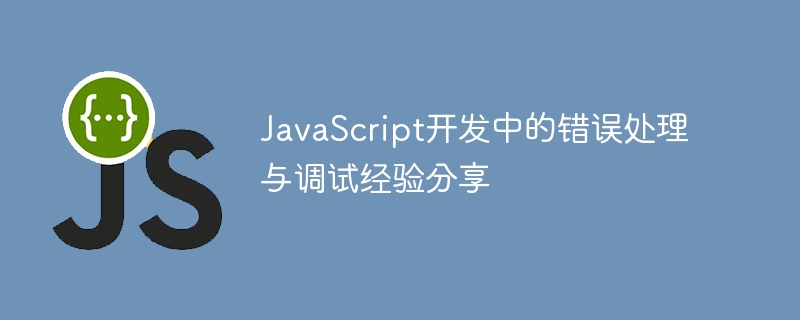

As a scripting language widely used in the field of Web front-end development, JavaScript error handling and debugging are a very important part of the development process. In the process of web application development, various exceptions and errors often occur. If they are not handled and debugged in time, they will have a serious impact on the stability of the application and the user experience. This article mainly shares error handling and debugging experience in JavaScript development to help developers quickly solve errors and improve application stability.
1. Error handling
In JavaScript, there are three types of errors: syntax errors, runtime errors and logic errors. Syntax errors in code are the most common and easy to find. Such errors usually refer to spelling errors, missing semicolons or brackets, etc. These errors can be detected through the syntax checking tool of development tools (such as Visual Studio Code) during code writing. Automatically check it out and give prompts.
Run-time errors usually refer to errors that occur when writing code. These errors may be due to incorrect logic and data exceptions in the code. This type of error usually requires debugging capabilities built into the development tools to troubleshoot and resolve them.
Logic errors usually refer to developers not paying attention to details when writing code, resulting in the code not running smoothly as expected. The resolution of such errors usually relies on the developer's experience and code debugging capabilities.
After understanding the three types of errors, let’s share some common error handling methods:
1. Use the try-catch statement
The try-catch statement is JavaScript One of the most commonly used error handling mechanisms in the code block, by using the try-catch statement in the code block, you can quickly catch exceptions in the code and handle them.
For example:
try {
//...
} catch (e) {
console.log("Error: ", e.message);}
In this code, if If an exception occurs in the try statement block, the catch statement block will capture and print out the corresponding error information.
2. Use the throw statement
The throw statement is a mechanism for throwing exceptions in JavaScript. You can use the throw statement to customize exception information in the code and throw exceptions.
For example:
function divide(x, y) {
if (y == 0) {
throw new Error("Division by zero");
}
return x / y;}
try {
var result = divide(10, 0); console.log(result);
} catch (e) {
console.log("Error: ", e.message);}
In this code, the function divide will check whether the denominator is 0. If it is 0, it will throw a custom exception message and stop running.
3. Use the console.log statement
console.log is a debugging tool built into JavaScript. By inserting the console.log statement into the code, you can quickly output some information for debugging.
For example:
function add(x, y) {
console.log("x = ", x);
console.log("y = ", y);
return x + y;}
In this code, every time the function add is called, console The .log statement will print out the values of x and y, making it easier for developers to debug.
2. Debugging experience sharing
In the JavaScript development process, incorrect debugging is a problem that our developers must face. Here is some sharing of debugging experience:
1. Use Chrome developer tools for debugging
The Chrome browser has built-in excellent developer tools, including JS debugging tools. Developers can use the developer tools in the Chrome browser to single-step debug the program, view variables and call stack information, etc.
2. Check code logic and data exceptions
In addition to syntax errors, frequently occurring errors may also be code logic and data exceptions, such as variable value type errors, array out-of-bounds, etc. Before debugging, we must confirm the correctness of the code logic and data.
3. Add logs to the code
When debugging, you often need to have a clear understanding of the code execution process. At this time, add some print variable values at key code locations. Or execute information statements, which can help developers quickly locate the problem.
4. Use breakpoints for debugging
When debugging complex programs, you can use breakpoints for debugging. Set code breakpoints at key locations, and then run the code through single-step debugging or step execution. You can clearly understand the execution process of the code, so you can better locate problems.
Conclusion:
In the JavaScript development process, good error handling and debugging experience can greatly improve developers’ development efficiency and application stability. Understanding common error handling methods and debugging techniques can help developers solve problems more quickly and improve development quality.
The above is the detailed content of Error handling and debugging experience sharing in JavaScript development. For more information, please follow other related articles on the PHP Chinese website!




